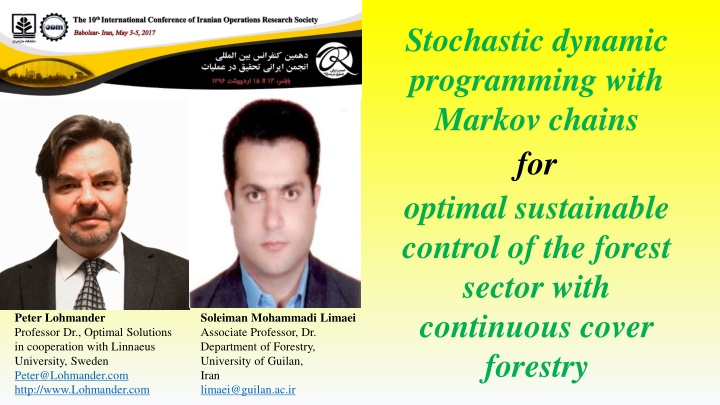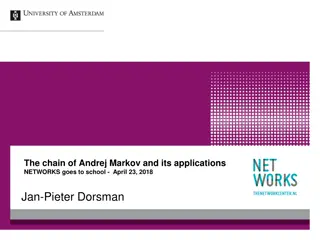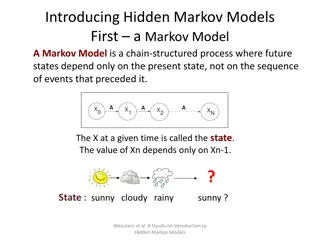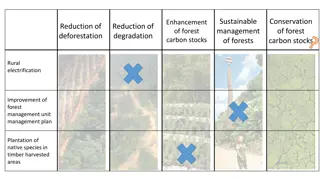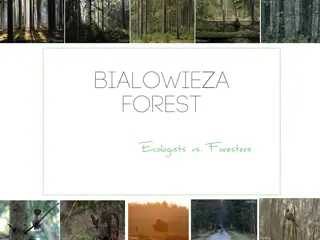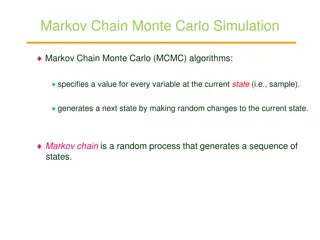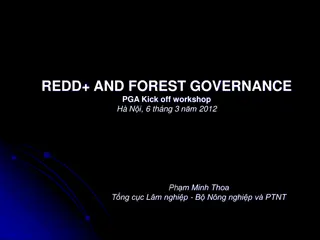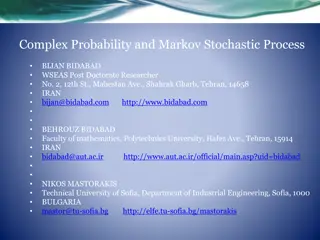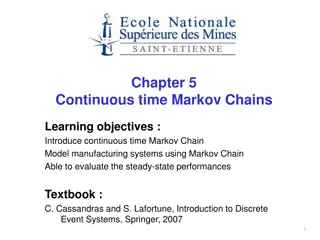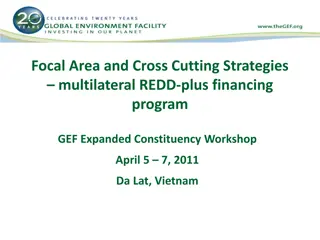Optimal Sustainable Control of Forest Sector with Stochastic Dynamic Programming and Markov Chains
Stochastic dynamic programming with Markov chains is used for optimal control of the forest sector, focusing on continuous cover forestry. This approach optimizes forest industry production, harvest levels, and logistic solutions based on market conditions. The method involves solving quadratic programming problems within a stochastic dynamic programming framework to ensure sustainability and profitability in the forest sector.
Download Presentation

Please find below an Image/Link to download the presentation.
The content on the website is provided AS IS for your information and personal use only. It may not be sold, licensed, or shared on other websites without obtaining consent from the author.If you encounter any issues during the download, it is possible that the publisher has removed the file from their server.
You are allowed to download the files provided on this website for personal or commercial use, subject to the condition that they are used lawfully. All files are the property of their respective owners.
The content on the website is provided AS IS for your information and personal use only. It may not be sold, licensed, or shared on other websites without obtaining consent from the author.
E N D
Presentation Transcript
Stochastic dynamic programming with Markov chains for optimal sustainable control of the forest sector with continuous cover forestry Peter Lohmander Professor Dr., Optimal Solutions in cooperation with Linnaeus University, Sweden Peter@Lohmander.com http://www.Lohmander.com Soleiman Mohammadi Limaei Associate Professor, Dr. Department of Forestry, University of Guilan, Iran limaei@guilan.ac.ir
Stochastic dynamic programming with Markov chains for optimal sustainable control of the forest sector with continuous cover forestry Peter Peter Lohmander Lohmander & & Soleiman Soleiman Mohammadi Mohammadi Limaei Limaei Abstract This paper presents a stochastic dynamic programming approach with Markov chains for optimal control of the forest sector. The forest is managed via continuous cover forestry and the complete system is sustainable. Forest industry production, logistic solutions and harvest levels are optimized based on the sequentially revealed states of the markets. Adaptive full system optimization is necessary for consistent results. The stochastic dynamic programming problem of the complete forest industry sector is solved. The raw material stock levels and the product prices are state variables. In each state and at each stage, a quadratic programming profit maximization problem is solved, as a sub problem within the STDP algorithm. Keywords: Optimization, Stochastic dynamic programming, Markov chains, Forest sector, Continuous cover forestry. 2
Introduction Introduction How should these activities in a typical forest industry sector be optimized and coordinated in the presence of stochastic markets: - Pulp and paper production and sales, - Sawn wood production and sales, - Wood based energy production and sales, - Raw material procurement and sales, - Harvest operations, and, - Logistic solutions? 3
Structure Structure of of the the method method: : For each year (or other period) and possible price and stock states, the profit is maximized using quadratic programming. The one year quadratic programming problems are considered as subproblems within a stochastic dynamic programming Markov chain master problem. The master problem can be solved via linear programming, and maximizes the expected present value of the forest sector over an infinite horizon. 4
200 180 Beech price at roadside (10 thousand Rials/m3) 160 140 120 100 80 60 40 20 0 2001 2003 2005 2007 2009 2011 2013 2015 Year Pulpwood price Fuelwood price Figure 1. The inflation adjusted prices at roadside in Iranian Caspian forests for beech used for different purposes, namely pulpwood and fuelwood. The inflation adjustment has been made via CPI, the consumer price index. (The prices are shown in the price level of 2016.) Note that the relation between the pulpwood price and the firewood price has changed considerably over time. [1]. 5
The forest sector includes several types of industrial plants, such as pulp mills, sawmills and wood based energy plants. The statistics clearly shows that such plants have paid very different prices for the raw materials from the forests. One illustration of this is found in Figure 1. This variation in relative input prices is most likely based on large variations in the relative prices in the pulp and energy markets. In order to optimize the total profitability of the sector, it is necessary to sequentially take price changes into account, and to adapt production in the optimal way. 6
The prices are not only difficult or impossible to predict perfectly. The prices are also affected by the volumes produced and sold in the markets. These production volumes are decision variables in the present maximization problem. A particular year, we may approximate the prices as linear functions of the production volumes. With higher volumes, the prices fall. The cost function is assumed to be convex. The profit function becomes a strictly concave quadratic function of production volumes. 7
If we control the forest sector with several types of mills and products, we may also derive prices of particular products as linear multidimensional functions of the production volumes of several products. In typical cases, the product prices may be negatively affected by the production volumes of similar products. As a result, the approximation of the total profit function becomes a strictly concave quadratic multidimensional function of all production volumes. With linear constraints, representing wood resources, mill capacities and logistic constraints, we obtain a quadratic programming maximization problem. Such a problem can be solved with standardized software and converges to the global maximum in a finite number of iterations. 8
and jx is the production volume of product j is the profit. jp jk r are profit function parameters. and is the capacity of resource i and i C is the amount of that resource used per unit of product . j ij 9
( ,..., x = + + + + max ) ... x p + + + 1 1 p x p x + 1 0 K K K + + + + 2 ... r x 12 1 2 r x x 1( r 1) 1 x x r x x 11 1 ... r x x 1 1 1 K K K K + + + + 2 ... r x x K K r x x KK r x 1 1 2 2 ( 1) 1 K K K K K K K + + ... 11 1 x x C 1 1 K K . . ... + st + ... 1 1 L x x C LK K L 10
The quadratic profit maximization problems should be solved each time new information concerning stochastic market changes appear. It is quite possible to use hours, days, weeks or years as periods. Each period, the following problem should be solved: max ( ,..., s t ; , , , ) x u t s m x 1 K . . + + ( , , , ) u t s m x ... ( , , , ) u t s m x ( , , , ) C u t s m 11 1 1 K K 1 ... + + ( , , , ) u t s m x ... ( , , , ) u t s m x ( , , , ) u t s m C 1 1 L LK K L 11
Note that the parameters of the maximization problem are functions of the changing values of ( , , , ). u t s m These variables represent: control decisions exogenous to the quadratic profit maximization problem, time, the state of the forest resource and the state of the markets. 12
The many quadratic profit maximization problems, one for each period, state of the forest and state of the markets, may be embedded within a stochastic dynamic programming problem of the following type: ( ) = max ( ,..., + + ( , , f t s m ) max u U t s m ; , , , t x u t s m ) ( ) ( 1, ( , ), t s u ) ( , , t s m ) 0 x m m f t s m t T + + + 1 1 1 1 t t K t t t t t t t t t ( , , ) . . s t t t t m + 1 t + + ... x K K x C 11 1 ... 1 1 + + LK K ... 1 1 x x C L L 13
( ) = max ( ,..., + + ( , , f t s m ) max u U t s m ; , , , t x u t s m ) ( ) ( 1, ( , ), t s u ) ( , , t s m ) 0 x m m f t s m t T + + + 1 1 1 1 t t K t t t t t t t t t ( , , ) . . s t t t t m + 1 t + + ... x K K x C 11 1 ... 1 1 + + LK K ... 1 1 x x C L L ( , , f t s m ) is the expected present value of the forest sector as a function of time, state of the forest and state of the markets, given that all future decisions are optimally taken, conditional on future information. t t is the set of feasible controls; controls that are exogenous to the period and state specific quadratic profit maximization problems. (.) U is the market state transition probability; the probability that the markets move from state ( ) m m in periodtto state t m t m+in the next period. + 1 t t 1 T denotes the one period discounting factor. is the time horizon. 14
Infinite time, Markov chains, stationarity and sustainability Sustainable systems are usually desired. We want the forests and the environment to last forever. Continuous cover forestry is easier to handle within the framework of dynamic programming than forestry with final harvests. Marginal harvest level changes more or less instantly affect the forest production level until the next period. With final harvests, the production is discontinuous and includes delays of many years between control and effects on the future wood flow. 15
Below, we make marginal changes of the problem, in order to make the exposition easier to follow. Now, denotes state . ti contains all of the information of ti ts and t m in the earlier part of this paper. = + + * * * ( , ) t i ( ; , ) t u t i ( | , , ) t t i u f ( 1, ) f i t i max u u + + 1 1 t t t t t i + 1 t t ( , ) U t i t t 16
Now, we assume stationarity. Hence, = ( , ) f t i ( ) f i We can determine the optimal values of ( ) = , in the following way: f i , denoted * * ( ) i f f i Note that: ( | , ) j i u f *( ; ) u i + , | i u u U i ( ) f i j j and + = ( | , j i u * * * * * j ( ; ) u i ) f f i j 17
if The optimal values of are determined via this linear programming problem: = min Z f i i s.t. * ( , ) ( ; ) u i , f j i u f i u i j u U i ( ) j 18
* iu , are those values of iu that make the constraints binding. The optimal decisions, In other words; The constrains with zero slack indicate the optimal decisions. 19
General properties of the solutions Of course, optimal numerical results are functions of the particular parameter values used. The estimation of these parameter values is an empirical problem that has no room in this short theoretical and general analysis. Related models have however been studied in the past. Some of the general conclusions derived from earlier numerically specified versions of similar models are these: 20
When the future prices of the final products are stochastic: The expected present value of the profit is higher when the suggested method is used instead of deterministic linear programing. The expected dual variables (shadow prices) associated with the industrial capacity restrictions are underestimated via deterministic multi period linear programming. Industrial flexibility is valuable and the optimal levels of maximum production capacities are higher than in a deterministic world. These results were reported by Lohmander [2]. More problem specific results may be obtained in several cases. Such results are reported in Lohmander [3], [4], [5], [6], [7] Lohmander and Mohammadi [8] and Olsson and Lohmander [9]. 21
Conclusions A general framework for forest sector optimization has been presented. Several examples of related studies and particular results have been reported. Considerable economic gains should be expected if the suggested method replaces traditional stiff long term planning methods. Furthermore, the forest is managed via continuous cover forestry, which leads to environmental advantages compared to forest management with clear fellings. The complete system is adaptive and sustainable. 22
Acknowledgments The first author greatly appreciates travel grants from FORMAS. 23
References Part 1(3) [1] Forests, Rangelands and Watershed Management Organization of Iran, Pulpwood price and the firewood price, Unpublished data, (2016). http://www.frw.org.ir/00/En/default.aspx [2] P. Lohmander, Stochastic dynamic programming with a linear programming subroutine: Application to adaptive planning and coordination in the forest industry enterprise. in Lohmander P. (Editor), Scandinavian Forest Economics, No. 31, 51p, (1989). http://www.Lohmander.com/Lohmander_STPLP_1990.pdf [3] P. Lohmander, P., Optimal stock and purchase policy with stochastic external deliveries in different markets, 12th Symposium for Systems Analysis in Forest Resources, The Inn Essex, Burlington, Vermont, USA, September 5-8, (2006). http://www.lohmander.com/Vermont2.ppt 24
References Part 2(3) [4] P. Lohmander, Stochastic Dynamic Optimization of Forest Industry Company Management, INFORMS International Meeting, (2007). http://www.Lohmander.com/SDO.ppt [5] P. Lohmander, Adaptive Optimization of Forest Management in a Stochastic World, in Weintraub A. et al (Editors), Handbook of Operations Research in Natural Resources, Springer, Springer Science, International Series in Operations Research and Management Science, New York, USA, (2007) 525-544. [6] P. Lohmander, Optimal adaptive stochastic control of large scale energy production under the influence of market risk, Keynote, 9th International Conference of the Iranian Society of Operations Research, IORC 2016, Shiraz University of Technology, Iran, April 27-30, (2016). http://www.Lohmander.com/PL_Shiraz_KEYNOTE_16.pdf http://www.Lohmander.com/PL_Shiraz_KEYNOTE_Paper_16.pdf 25
References Part 3(3) [7] P. Lohmander, Applications and mathematical modeling in operations research, Keynote, International Conference on Mathematics and Decision Science, International Center of Optimization and Decision Making & Guangzhou University, Guangzhou, China, September 12-15 (2016). http://www.Lohmander.com/PL_ICODM_2016_KEY.pdf http://www.Lohmander.com/PL_ICODM_2016_KEY_PAPER.pdf [8] P. Lohmander and S. Mohammadi Limaei, Optimal Continuous Cover Forest Management in an Uneven-Aged Forest in the North of Iran, Journal of Applied Sciences 8(11), 2008 1995-2007. http://ansijournals.com/jas/2008/1995- 2007.pdf [9] L. Olsson and P. Lohmander, Optimal forest transportation with respect to road investments, Forest Policy and Economics, 7(3) (2005) 369-379 http://dx.doi.org/10.1016/j.forpol.2003.07.004 26
Stochastic dynamic programming with Markov chains for optimal sustainable control of the forest sector with continuous cover forestry Peter Lohmander Professor Dr., Optimal Solutions in cooperation with Linnaeus University, Sweden Peter@Lohmander.com http://www.Lohmander.com Soleiman Mohammadi Limaei Associate Professor, Dr. Department of Forestry, University of Guilan, Iran limaei@guilan.ac.ir
